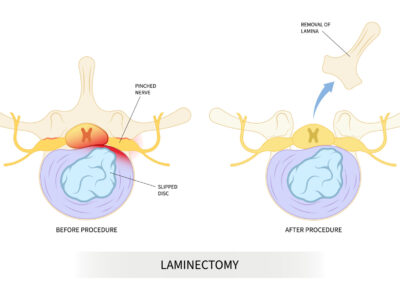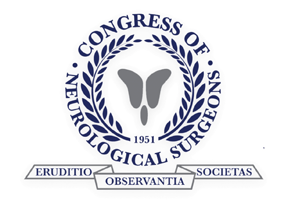A laminectomy is a surgical procedure, sometimes combined with a discectomy, to help relieve patients’ back or neck pain. During a laminectomy, your surgeon removes either part or all of the vertebral bone called the lamina, to make room for surgery or take pressure off the spinal cord or surrounding nerves.
Where Is the Lamina?
The human spine has 33 vertebrae, or bones that connect to make up the spinal column and protect the spinal cord. Each vertebra consists of 6 main areas, which are the:
- Vertebral body
- Pedicles
- Transverse processes
- Superior articular processes
- Lamina
- Spinous process

Whenever a laminectomy is required, the spinous process is automatically removed, as well. The surgeon may require removal of all of the lamina, but they may leave part of the bone intact if full removal is not necessary.
Why Might My Surgeon Require a Laminectomy?
There are several circumstances where a laminectomy is necessary for a successful spine surgery. Laminectomies can help in cases of:
- Disc herniation
- Spinal injury or trauma
- Spinal stenosis
- Tumor development
For disc herniation or tumor removal, your surgeon may need more room to access the removal site and will order a laminectomy to create the space they need to work.
In cases like spinal stenosis, removing the areas of bone that are either causing or adding to the pressure on the spinal cord or nerve roots via laminectomy can help ease patients from back pain that could otherwise be debilitating or limiting to their daily activities.
The most common reason for a laminectomy is a herniated disc, most often occurring in the lower back and resulting in sciatic nerve pain.
How Does a Laminectomy Work?
Patients who undergo a laminectomy can expect to sleep through the procedure under general anesthesia.
- You will be positioned either on your stomach or side so your surgeon can sterilize and access the surgical site.
- The surgeon will create an incision at the correct vertebra and separate the muscles to make room to work.
- The surgeon will complete the laminectomy by removing the parts of the bone that must come out. If you also require a discectomy or a spinal fusion, your surgeon will complete the steps for either procedure.
- Once your surgeon is finished, they will sew the incision closed with stitches or close with surgical staples.

What Can I Expect After My Laminectomy?
After a laminectomy, many patients will remain in the hospital or surgery center for at least one night for observation. Patients are usually able to gently walk and move around by the evening. Upon discharge, you will be prescribed pain management medication(s) and instructions on how to care for the incision site at home. You may receive bathing instructions, as well.
Patients should not operate a vehicle until your surgeon gives the OK to do so.
Recovery from a laminectomy tends to progress smoothly, but pay attention to signs like:
- An increase of pain at the incision site
- Drainage from the incision
- Fever
- Inability to control your bladder or bowels
- Leg, buttocks, or back numbness
- Redness and swelling at the incision site
Your surgeon will schedule a follow-up appointment to remove the stitches or staples and check to ensure recovery is going as expected.
What Are the Risks of Undergoing a Laminectomy?
Laminectomies are one of the more common, less invasive spine surgeries. However, like with any operation that requires anesthesia or incision, a laminectomy comes with a certain level of risk. You could experience:
- Excessive bleeding
- Infection
- Blood clots, wither in the legs or in the lungs
- Damage to the spinal cord or surrounding nerves
- Complications due to general anesthesia
The spinal column is an extremely delicate structure in the body, as are the spinal cord and surrounding nerves that the column supports and protects. While rare, surgical activity in that area can lead to damage to the nerves or blood vessels, and the patient can experience continued nerve pain that may increase following the procedure.
Patients in Middle Georgia who require spinal surgery, including a laminectomy, can rely on the expert neurosurgeons at Georgia Neurosurgical Institute.
Our spine specialists are pioneers in surgical technology and bring years of intensive training to deliver successful surgical solutions for your spinal condition. Schedule an appointment with our team today and learn more about our laminectomy procedures: 478-743-7092
Thanks for checking out part two of our 3-part series on minimally invasive spinal solutions! Stay tuned for the remaining articles in our series:
- Spinal Solutions: Discectomy
- Spinal Solutions: Laminectomy
- Laminectomy & Discectomy: What Are the Differences?
Related Articles






